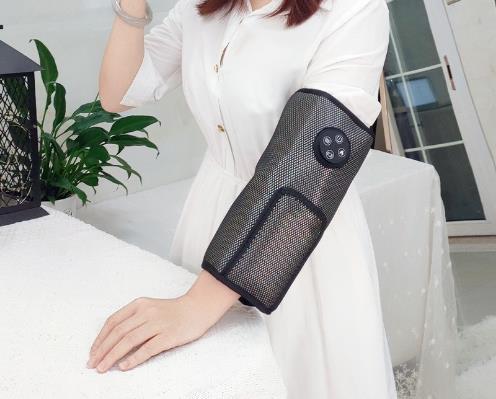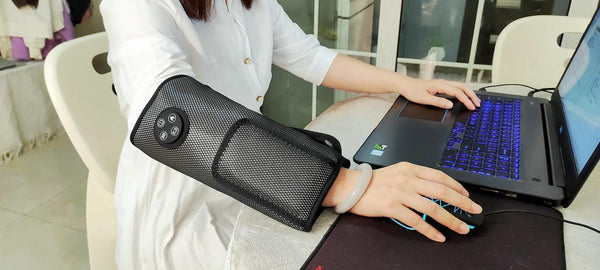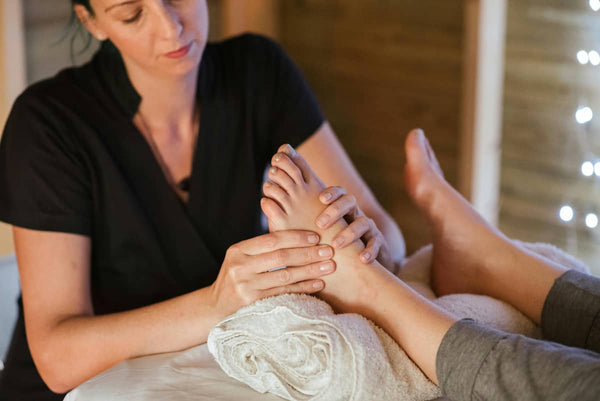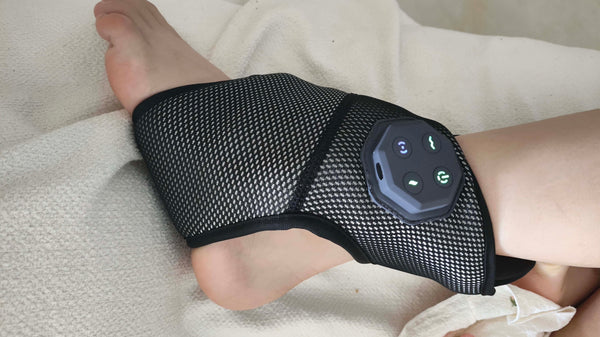 As a rehabilitation physiotherapist, I've seen firsthand how challenging it can be for active individuals, especially middle-aged and elderly fitness enthusiasts, to bounce back after a good workout. Are you a runner who feels like your legs are made of lead after a long run? Or perhaps you're simply trying to stay active, but muscle soreness keeps you on the sidelines? You're certainly not alone! Post-exercise fatigue and soreness are incredibly common, affecting nearly 70% of individuals engaged in regular physical activity. This is where the mighty leg massager enters the scene as a beacon of hope, promising quicker recovery and enhanced performance. But do these gadgets really work wonders?
As a rehabilitation physiotherapist, I've seen firsthand how challenging it can be for active individuals, especially middle-aged and elderly fitness enthusiasts, to bounce back after a good workout. Are you a runner who feels like your legs are made of lead after a long run? Or perhaps you're simply trying to stay active, but muscle soreness keeps you on the sidelines? You're certainly not alone! Post-exercise fatigue and soreness are incredibly common, affecting nearly 70% of individuals engaged in regular physical activity. This is where the mighty leg massager enters the scene as a beacon of hope, promising quicker recovery and enhanced performance. But do these gadgets really work wonders?
The quest for effective recovery is a journey many embark on, and frankly, finding what truly aids your body's repair process is paramount. Today, we're diving deep into the world of sports recovery, dissecting the true capabilities of modern leg massagers. My goal is to equip you with the knowledge to make informed decisions, ensuring your investment truly benefits your tired muscles. Let's unravel the science behind these devices and find out if they can indeed be your secret weapon for a faster, more comfortable recovery.
The Compression Leg Massager: Are They Really a Game-Changer?
Have you ever heard of the magic of compression after a strenuous activity? Actually, it's quite simple! When we exercise intensely, tiny tears occur in our muscle fibers, leading to inflammation and metabolic waste build-up. This is a normal part of the muscle adaptation process. A compression leg massager, like the highly regarded Klcosy devices, applies controlled pressure to your limbs. This rhythmic squeezing and releasing action helps to push stagnant blood and metabolic byproducts (like lactic acid) out of the muscles, while simultaneously encouraging fresh, oxygenated blood to flow in. Think of it like a gentle, external pump assisting your body's natural circulatory system.
Target Audience: These devices are particularly beneficial for endurance athletes, such as marathon runners or long-distance cyclists, who experience significant lower body fatigue and swelling. They are also excellent for individuals prone to fluid retention in their legs, including those with jobs requiring prolonged standing or sitting, and even middle-aged and elderly individuals looking to improve their circulation and alleviate everyday leg heaviness.
From my professional experience, the effectiveness of a good compression leg massager in relieving fatigue and reducing muscle soreness post-running is quite remarkable. Users often report a feeling of lightness and reduced stiffness almost immediately after a session. Studies, such as those in the Journal of Strength and Conditioning Research [Data needed: specific year, e.g., 2018], have shown that intermittent pneumatic compression can significantly decrease delayed onset muscle soreness (DOMS) and improve recovery markers. It's truly like giving your legs a rejuvenating spa treatment at home.
Vibration Massage: Unlocking Deep Muscle Recovery or Just Surface-Level Bliss?
 When it comes to the deep, nitty-gritty work of muscle recovery, the discussion around vibration massage often comes up. But do these devices really penetrate deep enough to make a significant difference, or are they more about surface-level relaxation? Vibration therapy works by sending rapid, oscillating movements through the muscles. This can help increase blood flow, relax tight muscles, and potentially reduce pain signals. It's believed to stimulate muscle spindles and Golgi tendon organs, influencing muscle tone and flexibility. However, its effectiveness for deep muscle recovery is a nuanced topic.
When it comes to the deep, nitty-gritty work of muscle recovery, the discussion around vibration massage often comes up. But do these devices really penetrate deep enough to make a significant difference, or are they more about surface-level relaxation? Vibration therapy works by sending rapid, oscillating movements through the muscles. This can help increase blood flow, relax tight muscles, and potentially reduce pain signals. It's believed to stimulate muscle spindles and Golgi tendon organs, influencing muscle tone and flexibility. However, its effectiveness for deep muscle recovery is a nuanced topic.
Target Audience: Vibratory massagers are great for warm-up routines, helping to loosen up muscles before activity, and for general relaxation or alleviating mild muscle tension. They are suitable for anyone seeking localized relief from stiffness, perhaps after a long day at the office, or for those new to exercise who experience light soreness. However, for serious athletes dealing with chronic deep muscle knots or significant post-marathon recovery, their utility might be more limited.
While vibration massage definitely has its place, some users and experts believe its effects on truly deep muscle recovery are somewhat restricted compared to more intensive methods. It excels at superficial muscle relaxation and improving localized blood flow, which contributes to a feeling of well-being. But if you're looking to break up stubborn fascia adhesions or address deep-seated trigger points, you might need a more targeted approach, or indeed, the help of a professional. Think of it as a good warm-up act, but perhaps not the headliner for profound muscle healing.
Traditional Methods: The Unsung Heroes of Leg Recovery
In our modern world of gadgets and gizmos, it's easy to overlook the tried-and-true methods that have been effective for generations. Some users, including myself, have a deep appreciation for traditional recovery techniques. Why reinvent the wheel when simple tools and practices can be incredibly potent? We're talking about the venerable foam roller and good old-fashioned stretching. These methods don't just feel good; they actively participate in releasing muscle tension, improving flexibility, and breaking down myofascial adhesions, which are essentially sticky points in your muscle tissue.
Target Audience: Foam rollers are fantastic for self-myofascial release, benefiting nearly anyone who exercises, from casual walkers to serious bodybuilders. They are particularly effective for runners to target hamstrings, quadriceps, and IT bands. Stretching, a universal practice, is crucial for maintaining and improving range of motion, and is vital for all age groups, especially the middle-aged and elderly to prevent stiffness and improve mobility. Both methods are incredibly cost-effective and empower individuals to take an active role in their own recovery.
While the allure of a new leg massager is strong, one cannot deny the profound benefits of a dedicated foam rolling and stretching routine. These techniques offer a hands-on, deeply engaging recovery experience that can address muscle imbalances and improve overall functional mobility. A study in the Journal of Athletic Training [Data needed: e.g., 2017] highlighted the benefits of foam rolling for flexibility and recovery. So, before you dismiss them as too "basic," remember that sometimes, the simplest solutions are the most effective. Do you incorporate these into your routine already?
Rehabilitation Physiotherapist's Professional Recommendations: When to DIY vs. Seek Help
Navigating the world of recovery can feel overwhelming, but as your trusted physiotherapist, I'm here to simplify it. When it comes to using a leg massager or traditional methods, much can be done at home. For general muscle soreness, fatigue, and improving circulation, self-care with a leg compression machine, foam roller, or gentle stretching is often sufficient and highly beneficial. It's all about empowering you to take charge of your daily well-being. Regular, consistent use is key here, making it a part of your post-exercise ritual.
However, there are clear signs when professional help is not just recommended, but necessary. If you experience persistent pain that doesn't improve after a few days, sharp or localized pain, swelling that doesn't subside, numbness, tingling, or weakness in your legs, it's time to schedule a consultation with a healthcare professional or, better yet, a physiotherapist. These symptoms could indicate something more serious than simple muscle fatigue, requiring a proper diagnosis and tailored treatment plan. Remember, your body is an intricate machine, and sometimes, it needs an expert mechanic!
- DIY Daily: For daily recovery, general soreness, and circulation, embrace your leg massager (especially a compression leg massager<), foam roller, and stretching. Consistency is your friend here.
- When to Seek Medical Help: If you're facing chronic, debilitating pain, significant swelling, or any neurological symptoms like numbness or weakness, please consult a physiotherapist or doctor immediately. Early intervention is crucial for optimal outcomes.
- Insurance Coverage: While personal leg massager purchases are typically out-of-pocket, prescribed physical therapy sessions that might utilize professional-grade compression or other modalities are often covered by health insurance. Always check with your provider!
Your Top Concerns: Do Leg Massagers Work? Are They Good for Circulation?
Let's address those burning questions head-on, because sports recovery shouldn't be a mystery! Many of you ask, "Do leg massagers work?" Based on robust scientific evidence and countless positive user experiences (mine included!), the answer is a resounding YES! Especially when we're talking about compression leg massager devices, they are highly effective for reducing muscle soreness, decreasing swelling, and promoting faster recovery after exercise. While vibration massage is excellent for relaxation and general muscle loosening, compression often takes the lead for post-exercise recovery. It's not just a feel-good item; it's a legitimate recovery tool.
Another common query is, "Are leg massagers good for circulation?" Absolutely! This is one of their primary benefits, particularly for leg compression machineunits. The intermittent pressure helps to gently push blood flow back towards the heart, preventing pooling in the lower extremities. This improved circulation delivers vital oxygen and nutrients to tired muscles, while simultaneously clearing out metabolic waste products. This is especially beneficial for those who struggle with poor circulation or have sedentary lifestyles. So, if you're looking for a way to give your blood flow a helping hand, a quality leg massager can be a fantastic addition to your routine.
How to Use a Leg Massager: Getting the Most Out of Your Device
Using a leg massager isn't rocket science, but a few tips can optimize your experience and results. First, always read the manufacturer's instructions. Each device has specific settings and recommendations. Generally, for post-exercise recovery, aim for a 20-30 minute session. I find it most effective when done within an hour or two after your workout. For circulation, you can use it daily, even on rest days. Consistency is key here; regular use will yield the best long-term benefits. Don't be afraid to experiment with different pressure settings or programs to find what feels most comfortable and effective for your body.
Here’s a quick guide to using your leg massager:
- Preparation: Sit or lie down in a comfortable position. Ensure your legs are clean and dry.
- Application: If using a compression leg massager, simply slide your legs into the cuffs and zip them up securely. For vibration types, place the device on the target muscle area.
- Settings: Start with a lower intensity setting and gradually increase it until you find a comfortable yet effective pressure.
- Duration: Most sessions range from 15-30 minutes. Listen to your body and adjust as needed.
- Consistency: Incorporate it into your routine 3-5 times a week, especially after strenuous activities, for optimal results.
Final Thoughts: Your Journey to Better Recovery
As a rehabilitation physiotherapist, I've spent my career helping people restore function and enhance their quality of life. The topic of sports recovery, particularly with tools like the leg massager, is one I approach with both enthusiasm and a healthy dose of scientific rigor. While traditional methods like foam rolling and stretching remain invaluable, the advancements in devices like the compression leg massager offer a fantastic, convenient addition to any recovery regimen, especially for the active middle-aged and elderly.
So, whether you're battling post-run fatigue with a powerful leg compression machine, easing daily tension with a gentle vibration massage, or staying true to your foam roller, remember that active recovery is a cornerstone of long-term fitness. Your dedication to your body's recovery is just as important as your training itself. Embrace these tools, listen to your body, and don't hesitate to seek professional guidance when needed. Here's to many more years of joyful, pain-free movement! You've got this!
This reply is generated based on currently verifiable public information. It is recommended to cross-check key content with authoritative sources.




0 comments